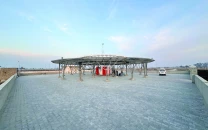WWF warns infrastructure developments threaten existence of snow leopards
Highways, transmission lines, infrastructure networks increasingly bringing snow leopards close to human settlements

The construction of new roads, highways, transmission lines, and infrastructure networks is bringing humans and Pakistan’s iconic snow leopards dangerously close, warned the World Wide Fund for Nature on the occasion of International Snow Leopard Day.
In a statement, WWF-Pakistan highlighted that development projects are narrowing the distance between the two, creating new challenges for the survival of the endangered species.
The spread of highways, power transmission lines, and infrastructure networks is increasingly pushing snow leopards toward human settlements, raising the risk of conflict and threatening their long-term survival.
According to the WWF-Pakistan, the country’s first-ever Road Ecology Study has revealed that road infrastructure is fragmenting the snow leopard’s natural habitats.
Construction activities and expanded roads are disrupting their movement patterns, while heavy traffic along the Karakoram Highway has caused noise and air pollution that could affect wildlife breeding and migration, particularly within the Khunjerab National Park.
The study also noted that road expansion is also affecting populations of other mountain species, such as ibex and blue sheep.
As we near World Snow Leopard Day, meet the Ghost of the Mountains in this tale from our series #WildLegendsofPakistan.
— WWF-Pakistan (@WWFPak) October 21, 2025
In the folklore of mountain communities, the snow leopard is believed to be a spirit guardian, a protector of sacred highlands and a symbol of strength,… pic.twitter.com/NUmnWLdmtU
WWF-Pakistan, which has been working on snow leopard conservation since the 1990s, has deployed AI-powered cameras at key hotspots to monitor wildlife activity.
These smart cameras provide real-time data that can also be used to protect livestock and reduce human-wildlife conflict. The system, introduced in the beginning of 2025, has shown high accuracy in detecting species — offering a promising tool for their coexistence.
Additionally, WWF-Pakistan has introduced a technology called SMART (Spatial Monitoring and Reporting Tool) in collaboration with the wildlife departments of Khyber-Pakhtunkhwa and Gilgit-Baltistan.
This software supports standardised patrol protocols, real-time data collection, and monitoring of snow leopard movements, illegal hunting, disease outbreaks, and other threats.
WWF-Pakistan’s Senior Director of Programmes, Rab Nawaz, emphasised, while roads play a crucial role in community connectivity and regional development, they can also pose severe risks to mountain wildlife if not responsibly designed.
“Through smart technology, we are assessing the population status of snow leopards. The integration of artificial intelligence and real-time monitoring will be vital in transforming potential conflicts between humans and wildlife into opportunities for coexistence,” he said.
He stressed the urgent need to ensure that human development does not come at the cost of the survival of this rare and magnificent species.























COMMENTS
Comments are moderated and generally will be posted if they are on-topic and not abusive.
For more information, please see our Comments FAQ